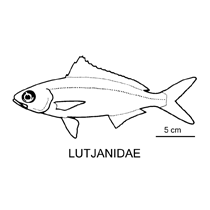- Classification
- ACTINOPTERYGII
- PERCIFORMES
- LUTJANIDAE
-
Fish Classification
-
Class
ACTINOPTERYGII Ray-finned fishes -
Order
PERCIFORMES Perches and allies -
Family
LUTJANIDAE Tropical snappers, fusiliers
Family LUTJANIDAE
Small to large predatory fishes usually found in tropical and subtropical reef and mangrove habitats.
Lutjanids are generalised percoid fishes with a robust, relatively elongate body, a single dorsal fin (usually with 10 or 11 spines), and well-developed canine teeth in jaws.
Most lutjanids live above 100 m near coral reefs, although some species are found in deeper waters to 500 m.
Tropical snappers are active predators and feed mostly at night. The fusiliers are schooling fishes that feed on zooplankton in the water column.
More Info
|
Family Taxonomy |
Worldwide, the family comprises 123 species in 21 genera. A total of 61 species in 14 genera are known from Australia. The family comprises two subfamilies: Caesioninae and Lutjaninae, which are treated as families by some authors. |
|
Family Distribution |
Lutjanids are found in all tropical and subtropical seas, although fusiliers (subfamily Caesioninae) are restricted to warm seas of the Indo-west Pacific region. Most species are associated with coral reefs, although members of the genera Etelis, Lipocheilus, Paracaesio, Pristipomoides, and Randallichthys are associated with continental shelf waters to depths as great as 500 m. |
|
Family Description |
Dorsal fin X-XII, 8-18; Anal fin III, 7-11; Vertebrae 24. Lutjanids are generalised percoid fishes with a robust, relatively elongate body; single dorsal fin (frequently containing 10 or 11 spines); upper jaw somewhat protrusible, maxilla expanded posteriorly, sliding beneath suborbital bone for much of its length; jaws usually with well-developed canine teeth; scales absent from snout and preorbital region. Fusiliers (Caesioninae) are closely related to tropical snappers (Lutjaninae). Although they share a number of similarities with snappers, they have a distinctive jaw morphology. The upper jaw is highly protrusible, an adaptation for their planktonic diet. In addition, they are generally more slender than most snappers, and the tail is strongly forked. |
|
Family Size |
The maximum length is about 1 m (Lutjanus sebae), but most species are under 50 cm (60 cm for fusiliers). |
|
Family Colour |
Colour highly variable, usually ranging form yellow to red to blue, often with blotches, lines and stripes. |
|
Family Feeding |
Carnivores - active predators feeding at night mostly on bottom-living fishes, as well as on crabs, shrimps, molluscs and polychaete worms. The pelagic fusiliers form large schools and feed on zooplankotn in the water column. |
|
Family Commercial |
Lutjanids are important commercial and recreational species throughout their range. They are taken in bottom trawls, handlines, longlines and fish traps. The flesh is highly regarded, although some species reportedly caude ciguatera (food poisoning). |
|
Family Conservation |
A number of species considered to be threatened on the IUCN Red List of Threatened Species |
|
Author |
Bray, D.J. 2018 |
References
Allen, G.R. 1985. FAO Species Catalogue. Vol. 6. Snappers of the World. An annotated and illustrated catalogue of lutjanid species known to date. FAO Fisheries Synopsis No. 125, Vol. 6. 208 pp.
Allen, G.R. & Talbot, F.H. 1985. Review of the snappers of the genus Lutjanus (Pisces: Lutjanidae) from the Indo-Pacific, with the description of a new species. Indo-Pacific Fishes 11: 1–87
Anderson, W.D. & Allen, G.R. (2001). Lutjanidae. pp. 2840–2918 in Carpenter, K.E. & Niem, V.H. (eds) The Living Marine Resources of the Western Central Pacific. FAO Species Identification Guide for Fisheries Purposes. Rome : FAO Vol. 5 pp. 2791–3379
Carpenter, K.E. (1987). Revision of the Indo-Pacific fish family Caesionidae (Lutjanoidea), with descriptions of five new species. Indo-Pacific Fishes 15: 1–56 figs 1–10 pls 1–7
Carpenter, K.E. (1988). FAO Species Catalogue. Fusilier fishes of the World. An annotated and illustrated catalogue of caesionid species known to date. FAO Fisheries Synopsis No. 125, Vol. 8. 75 pp.
Carpenter, K.E. (2001). Caesionidae. pp. 2919–2941 in Carpenter, K.E. & Niem, V.H. (eds) The Living Marine Resources of the Western Central Pacific. FAO Species Identification Guide for Fisheries Purposes. Rome : FAO Vol. 5 pp. 2791–3379
Hutchins, J.B. (2001). Checklist of the fishes of Western Australia. Rec. West. Aust. Mus. Suppl. 63: 9–50
Miller, T. L. & Cribb, T.H. 2007. Phylogenetic relationships of some common Indo-Pacific snappers (Perciformes: Lutjanidae) based on mitochondrial DNA sequences, with comments on the taxonomic position of the Caesioninae. Molecular Phylogenetics and Evolution 44:450–460.





































































































































































































































































































































